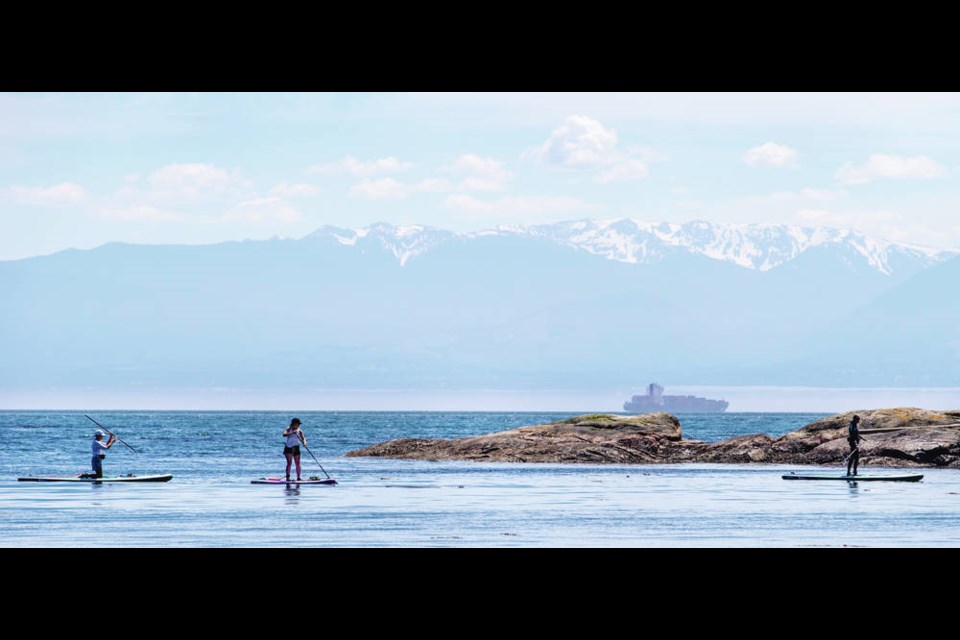Environment Canada has issued a heat warning for Greater Victoria and the east coast of Vancouver Island this weekend, with temperatures expected to reach as high as 36 C.
The special weather statement warns of temperatures ranging from 29 C to 36 C in Greater Victoria, the southern Gulf Islands and much of the Lower Mainland from today to at least Tuesday, as a result of an exceptionally strong ridge of high pressure developing over the province. At night, the temperature is expected to dip to just 18 to 20 C.
Those numbers are about 10 degrees above seasonal averages.
Armel Castellan, a meteorologist with Environment Canada, said a heat wave this early in the season is unprecedented, and will likely break all-time temperature records for June. “This is weather that we usually would expect in late July, not June,” said Castellan, noting it comes amid one of the driest Junes on record.
In the B.C. Interior, temperatures could reach 45 C, breaking the all-time Canadian record, he said.
Castellan said high night temperatures could affect our sleep.
“It becomes a big problem because people can’t recover enough to face another day of heat. The problem is more pronounced on the coast, because we have fewer air-conditioners per capita than the Interior.”
To escape the heat, many people are expected to flock to the region’s watering holes and beaches.
But even at the beach, you may not be able to count on a cooling breeze coming off the water in the next few days due to the high-pressure system.
“The Pacific Ocean is usually our natural air conditioner — a wonderful reprieve from the heat most of the time. But the system will switch that off,” said Castellan.
At Gonzales Beach on Thursday, Ryan Mijker, who was carrying his five-year-old daughter Frankie Berniaz home from a preschool outing, said he has no problem with the heat.
“This is awesome,” he said.
“I have been in Victoria for the last 10 years, but before then, I was living in the Okanagan, so I love the heat.”
Adrienne David, who was returning from the same preschool outing with her daughter Alice Martinak, 3, said she feels lucky to live in Victoria.
“The kids spend countless hours playing on the beach.”
CRD Parks, which manages 31 parks in the regional district, advised people to consider visiting their local parks at non-peak hours to avoid crowded parking lots, or to choose less-frequented parks. The region’s parks saw more than 8.5 million visits last year — an increase of 13 per cent from 2019.
Jeff Leahy, senior manager for CRD Regional Parks, said the regional district will be maintaining a greater presence in parks this year to ensure people are using them in a safe manner. “We will have bylaw officers and park rangers providing awareness and educating the public.”
One recurring problem is people jumping off the cliffs bordering Thetis Lake Park, despite signs warning of rocks just below the surface.
The heat can also be a problem for the SPCA when people leave dogs in hot cars. Lorie Chortyk, general manager of communications with the B.C. SPCA, says it’s a bad idea, even if you’re parked in the shade with the windows open. “You don’t realize how quickly temperatures can rise and dogs can’t release heat as we do — they have no sweat glands. Dying from heat is horrible for both the pet and owner. Dogs are always safer at home. If you love them, leave them home.”
Chortyk said last year, the B.C. SPCA received 800 calls across the province about dogs being left in cars on hot days.
According to Castellan, this weekend won’t be just a blip. “We are forecasting a summer of above-average temperatures and this is a precocious start with the deck already stacked against us.”
parrais@timescolonist.com
Sun-safety tips
The Save your Skin Foundation recommends seeking shade whenever possible and limiting your exposure between 10 a.m. and 4 p.m. when the sun is strongest.
It suggests wearing long-sleeved clothing, wide-brimmed hats and full-spectrum sunglasses and using sunscreen with an SPF of at least 30 on all exposed skin.
The precautions help prevent skin cancer, the most common type of cancer and one of the most preventable. Skin cancer is primarily caused by overexposure of the skin to UV radiation.



